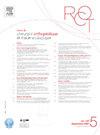Résultats cliniques et radiologiques des fractures de Bennett ostéosynthésées par brochage selon Iselin : étude rétrospective à propos de 29 patients au recul moyen de 6 ans (2–14)
Q4 Medicine
Revue de Chirurgie Orthopedique et Traumatologique
Pub Date : 2025-02-01
DOI:10.1016/j.rcot.2024.10.003
引用次数: 0
Abstract
Introduction
Le brochage percutané selon Iselin est une technique employée dans le traitement des fractures de Bennett. Peu d’études ont publié les résultats à moyen et long termes de ces ostéosynthèses, le suivi moyen étant de 4 ans dans la plupart des séries. L’objectif principal de cette étude était d’évaluer les résultats fonctionnels et cliniques du brochage selon Iselin avec un recul moyen de 6 ans. L’objectif secondaire était d’évaluer l’apparition d’arthrose trapézométacarpienne (TM) radiographique.
Hypothèses
(1) Les résultats fonctionnels étaient bons et les résultats cliniques comparables au côté controlatéral ; (2) Une arthrose TM radiographique apparaissait à moyen terme mais n’entravait pas la reprise des activités professionnelles et de loisir.
Patients et méthodes
Il s’agissait d’une étude rétrospective, monocentrique, multi-opérateurs. Vingt-neuf patients ont été étudiés avec un recul moyen et médian de 6 ans (extrêmes 2–14). Les critères fonctionnels (satisfaction, douleur, sensation de perte de force, DASH), cliniques (force au Tip-pinch, Key-pinch, Grasp comparés au côté controlatéral) et de mobilité (angle d’abduction, score d’opposition de Kapandji) étaient évalués. La reprise des activités professionnelle et de loisir a été recherchée. L’arthrose trapézométacarpienne était évaluée selon la classification radiographique d’Eaton-Littler sur des clichés de pouce de profil en position neutre.
Résultats
La satisfaction moyenne était de 87 % (20–100). La douleur moyenne au repos et à l’effort était de 0,7/10 (0–8) et 2/10 (0–10) respectivement. La sensation subjective de perte de force était de 12,2 % ± 15,9. Le DASH moyen était de 8,8/100 (0–43). La force de préhension moyenne au Tip-pinch test était significativement diminuée par rapport au côté controlatéral : −9,3 % ± 16,5 et également pour le Key-pinch test : respectivement −6,3 % ± 16,9. L’abduction du pouce était significativement diminuée par rapport au côté controlatéral : −4,1° ± 5,24 ainsi que pour le score d’opposition de Kapandji : −0,5 ± 0,81. Les radiographies retrouvaient 100 % d’arthrose TM (96 % de stade 1 ou 2).
Discussion
Le traitement des fractures de Bennett par brochage selon Iselin est une technique chirurgicale qui offrait des résultats fonctionnels satisfaisants à moyen terme, sous réserve d’une perte de force et de mobilité modérée mais systématique.
Niveau de preuve
IV ; étude rétrospective monocentrique.
Introduction
The percutaneous pinning method described by Iselin is one of the techniques used for treating Bennett fractures at the base of the thumb metacarpal. There is little published data on the medium- and long-term outcomes of this treatment, with most studies having a mean follow-up of 4 years. The primary objective of this study was to evaluate the functional and radiological outcomes of percutaneous pinning by Iselin's method with a mean follow-up of 6 years. The secondary objective was to look for evidence of radiographic carpometacarpal (CMC) arthritis.
Hypotheses
(1) The functional outcomes are good, and the clinical outcomes are comparable to the contralateral side. (2) While radiographic CMC arthritis may be present in the medium term, it will not interfere with work and recreational activities.
Methods
This was a single-center, multiple-surgeon, retrospective case series. Twenty-nine patients were included who had a mean and median follow-up of 6 years (min 2, max 14). The functional outcomes (satisfaction, pain, subjective strength deficit, DASH), clinical outcomes (tip pinch, key pinch and grip strength compared to contralateral side) and the thumb's mobility (abduction angle, Kapandji score) were determined. Return to work and recreational activities were documented. CMC arthritis was assessed on lateral radiographs of the thumb in neutral position based on the Eaton–Littler classification.
Results
The average patient satisfaction score was 87% (20; 100). The mean pain level was 0.7/10 (0–8) at rest and 2/10 (0–10) during effort. The subjective strength deficit was 12% ± 16. The mean DASH score was 8.8/100 (0–43). The mean tip-pinch strength in the operated thumb was significantly lower than the contralateral side (−9.3% ± 16.5), as was the mean key-pinch (−6.3% ± 16.9). Thumb abduction was significantly reduced relative to the contralateral side (−4.1° ± 5.24) as was the Kapandji score (−0.5 ± 0.81). CMC arthritis was visible on 100% of radiographs (96% were stage 1 or 2).
Discussion
he surgical treatment of Bennett fractures by percutaneous pinning using the Iselin method produces satisfactory functional outcomes in the medium term, although there was a moderate loss of strength and mobility in the thumb.
Level of evidence
IV; retrospective, single-center case series.
根据Iselin, Bennett骨合成骨折的临床和放射结果:29例患者的回顾性研究,平均退行6年(2 - 14)
Iselin经皮穿刺是一种用于治疗Bennett骨折的技术。很少有研究公布这些骨合成的中期和长期结果,大多数系列的平均随访时间为4年。这项研究的主要目标是评价拼接的功能性及临床结果据Iselin与平均下降了6岁。次要目的是评估出现关节炎患者trapézométacarpienne radiographique.Hypothèses (TM)(1)临床实用效果很好,结果在一边controlatéral可比;(2)中期出现放射TM骨关节炎,但不妨碍恢复工作和休闲活动。这是一项回顾性的、单中心的、多操作者的研究。29例患者的中位回顾性为6年(极端情况2 - 14)。对功能标准(满意度、疼痛、力量丧失感、DASH)、临床标准(与对照侧相比的Tip- Pinch、Key- Pinch、抓地力)和流动性标准(拐角、Kapandji对立评分)进行了评估。人们寻求恢复职业和休闲活动。梯形跖骨是根据Eaton-Littler x射线分类法在中性位置测量的。平均满意度为87%(20 - 100)。休息和运动时的平均疼痛分别为0.7 /10(0 - 8)和2/10(0 - 10)。主观力量丧失感为12.2%±15.9。平均DASH为8.8 /100(0 - 43)。与对照组相比,针尖试验的平均握持力显著降低:- 9.3%±16.5,关键针尖试验的平均握持力分别降低了- 6.3%±16.9。拇指的扣减度明显低于对照组:- 4.1±5.24,而卡班吉的反对度为- 0.5±0.81。根据Iselin的说法,Bennett骨折的针托治疗是一种手术技术,在中等但系统地丧失力量和活动能力的情况下,在中期提供了令人满意的功能结果。证据等级IV;单中心回顾性研究。介绍Iselin描述的经皮钉法是用于治疗拇指跖骨底部贝尼特骨折的技术之一。这种治疗的中期和长期结果很少发表,大多数研究有平均4年的随访。本研究的主要目的是评估Iselin方法的经皮钉的功能和放射结果,并进行6年的平均随访。第二目的是寻找x线影像学掌骨(CMC)关节炎的证据。假设(1)功能结果良好,临床结果可与对侧相比较。(2)虽然放射CMC关节炎可能在中期出现,但它不会干扰工作和娱乐活动。这是一个单中心,多外科,回访病例系列。29例患者随访平均至中位6年(最小2年,最大14年)。确定了功能结果(满意度、疼痛、主观力量不足、DASH)、临床结果(与对侧相比的指尖捏紧、关键捏紧和抓地力)和拇指的活动能力(抓地力角度、卡潘吉评分)。返回工作和娱乐活动被记录下来。根据Eaton - Littler分类,在中性位置对拇指侧x光片进行CMC关节炎评估。结果:平均患者满意度为87% (20;100)。休息时的平均疼痛水平为0.7/10(0 - 8),运动时的平均疼痛水平为2/10(0 - 10)。主观力量赤字为12%±16。平均DASH分数为8.8/100(0 - 43)。手术后拇指的平均拇指捏紧力明显低于对侧(- 9.3%±16.5)和平均拇指捏紧力(- 6.3%±16.9)。与Kapandji评分(- 0.5±0.81)相比,相对于对侧(- 4.1°±5.24),拇指扣除率显著降低。CMC关节炎在100%的x光片上可见(96%在1期或2期)。使用Iselin方法对Bennett骨折进行经皮固定的讨论手术治疗,虽然拇指的力量和活动能力略有下降,但在中期产生了令人满意的功能结果。证据等级IV;回顾,单中心案例系列。
本文章由计算机程序翻译,如有差异,请以英文原文为准。
求助全文
约1分钟内获得全文
求助全文
来源期刊

Revue de Chirurgie Orthopedique et Traumatologique
Medicine-Surgery
CiteScore
0.10
自引率
0.00%
发文量
301
期刊介绍:
A 118 ans, la Revue de Chirurgie orthopédique franchit, en 2009, une étape décisive dans son développement afin de renforcer la diffusion et la notoriété des publications francophones auprès des praticiens et chercheurs non-francophones. Les auteurs ayant leurs racines dans la francophonie trouveront ainsi une chance supplémentaire de voir reconnus les qualités et le intérêt de leurs recherches par le plus grand nombre.
 求助内容:
求助内容: 应助结果提醒方式:
应助结果提醒方式:


